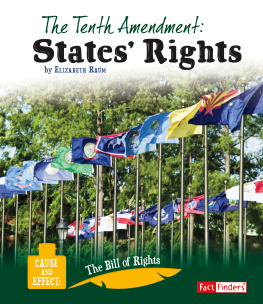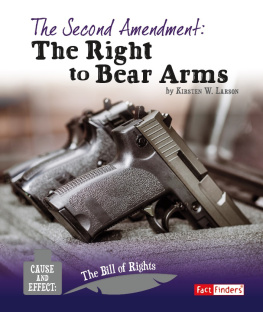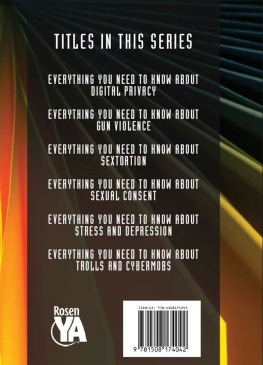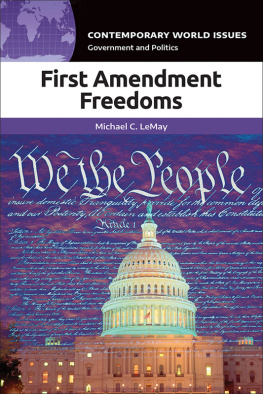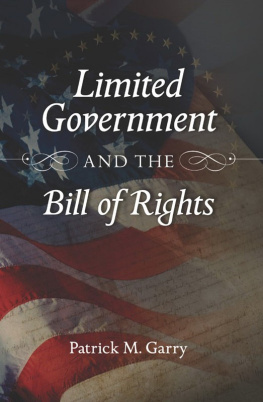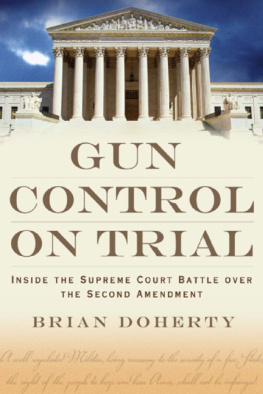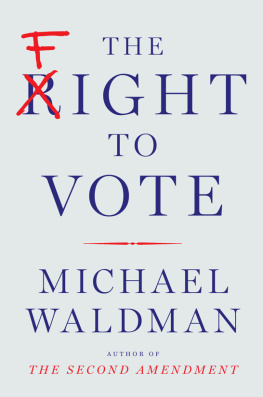ADDITIONAL PRAISE FOR
THE SECOND AMENDMENT
A welcome addition to the ongoing debate over gun rights and gun control in America.
The Buffalo News
An insightful look at both the historical foundation of the Second Amendment... a welcome re-injection of historical context into the present debate over the rightful role of guns in American culture.
Chicago Tribune
Terrific.
Nicholas Kristof for The New York Times
Compelling.
The Washington Post
Rigorous, scholarly, but accessible book.
The New York Times
Waldman relates this tale in clear, unvarnished prose and it should now be considered the best narrative of its subject.
Publishers Weekly
Waldman offers historical perspective on the fierce debate.... A lively and engaging exploration.
Booklist
Thoughtful, accessible... useful to anyone arguing either side of this endlessly controversial issue.
Kirkus Reviews
The ongoing debate about the Second Amendment and the right to bear arms continues to set off multiple explosions in the blogosphere. Waldmans new book will not make the most zealous NRA advocates happy, but for anyone who wants his or her history of the Second Amendment straight-up, this is the most comprehensive, accessible, and compelling version of the story in print.
Joseph J. Ellis, author of Founding Brothers
From the founding of the Republic to the Newtown massacre of elementary school children, and beyond, Michael Waldman vividly portrays the evolution of a nations passionate debate over the right to keep and bear arms. Activist, conservative justices on the U.S. Supreme Court may have thought they ended that debate in 2008, but with rich detail and crisp narrative, Waldman shows how it continues to reverberate across the landscape with important lessons for all Americans.
Marcia Coyle, author of The Roberts Court
Trough most of American history, the Second Amendment guaranteed the right to be a citizen-soldier, not an individual vigilante. With wit and erudition, Michael Waldman tells the story of how the Amendments meaning was turned upside-down and inside-out.
David Frum, author of The Right Man: An Inside Account of the Bush White House
Michael Waldman gives us the turbulent life story of the Second Amendment. If one clause of the Constitution better deserved a quiet retirement, it is our right to keep and bear arms, a vestige of the Founding Fathers concern with the role of the militia in a republican society. Yet today the Second Amendment has become one of the feistiest, most disputed clauses of the Constitution, and Waldman vividly explains why this obscure, minor provision has become so controversial.
Jack Rakove, author of Original Meanings
Partisan pseudo-histories of gun regulation and the Second Amendment abound. Michael Waldmans excellent book slices through the propaganda with candor as well as scholarship. It advances an authentic and clarifying history that will surprise and enlighten citizens on all sides of the issue. Here is a smart and cogent history that performs a large public service.
Sean Wilentz, author of The Rise of American Democracy
Anyone interested in the hot button issue of guns and their place in our society will find this book a helpful tool for ongoing discussion.
The Decatur Daily (Alabama)
The Second Amendment is a smart history of guns and the US... his calm tone and habit of taking the long view offers a refreshing tonic in this most loaded of debates.
Los Angeles Times
Waldmans detractors would do well to read the book, which focuses less on taking a position on gun control and more on explaining what the Founding Fathers intended when they approved the amendment and how subsequent decisions from the U.S. Supreme Court and elsewhere have transformed that intent.... Seeing the subject discussed and dissected in untypically calm, scholarly tones, then, is a refreshing development.
Miami Herald
Thank you for downloading this Simon & Schuster eBook.
Join our mailing list and get updates on new releases, deals, bonus content and other great books from Simon & Schuster.
C LICK H ERE T O S IGN U P
or visit us online to sign up at
eBookNews.SimonandSchuster.com
CONTENTS
To my family
INTRODUCTION
O n March 1, 1792, Secretary of State Thomas Jefferson issued a terse announcement. Congress had established the post office. It had passed a new law governing fisheries. And the states had ratified the first ten amendments to the Constitution: the Bill of Rights.
Jeffersons deadpan proclamation belied years of drama and conflict. The amendments were the product of a fierce debate over governments role and the rights of the people, one that unfolded since the start of the American Revolution. Even today, Americans know some parts of the Bill of Rights by heart. We cherish the First Amendment, with its guarantee of freedom of religion, speech, and the press. We debate the Fourth Amendment, with its requirement for a search warrant. All know about the right to avoid self-incrimination (taking the Fifth).
For two centuries, however, the Second Amendment received little notice. Few citizens understood its provisions. Scholars paid it little attention. Lawyers rarely raised it in court. In recent years, of course, the Second Amendment has been thrust to the center of controversy. Politicians declare themselves its strong supporters. News reports speculate about gun laws and whether they will pass muster. It has become a synonym, in powerful unspoken ways, for Americas gun culture.
The Second Amendment is one sentence. It reads in its entirety:
A well regulated militia, being necessary to the security of a free state, the right of the people to keep and bear arms, shall not be infringed.
Its foggy wording and odd locution stand out in the Constitution. Lawyers and scholars debate its commas and clauses. For 218 years, judges overwhelmingly concluded that the amendment authorized states to form militias, what we now call the National Guard. Then, in 2008, the U.S. Supreme Court upended two centuries of precedent. In the case of District of Columbia v. Heller , an opinion written by Justice Antonin Scalia declared that the Constitution confers a right to own a gun for self-defense in the home. Thats right: the Supreme Court found there to be an individual right to gun ownership just a few years ago. Now, when we debate gun control we do so in the context of a Supreme Court ruling that limits what we can do (though we dont yet know how much).
Far from a dry set of words scratched on parchment, then, it turns out that the story of the Second Amendment can tell us much about how our country has changed and grown, how we see ourselves and our government, how we balance the rights of individuals and the need for safety.
Part One of this book begins in the tumultuous years of the American Revolution and its aftermath. The Constitution was drafted in secret by a group of mostly young men, many of whom had served together in the Continental Army, and who feared the consequences of a weak central authority. They produced a charter that shifted power to a national government. Anti-Federalists opposed the Constitution. They worried, among other things, that the new government would try to disarm the thirteen state militias. Critically, those militias were a product of a world of civic duty and governmental compulsion utterly alien to us today. Every white man age sixteen to sixty was enrolled. He was required to ownand bringa musket or other military weapon.




